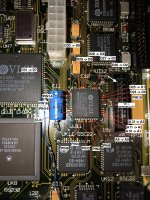ronan
Well-known member
Hi everyone,
I'm becoming crazy as I have huge trouble making my original floppy drive work reliably. I have been investigating this for more than one week nearly full time.
It looks like my drive is working sometimes but not always :
Sometimes it will just eject the drive quickly. Sometimes I will be able to format a disk, write to it and read from it with no issues. I am also able to write disk images using a modern mac and sometimes see the files on the SE/30 itself.
I sometimes manage to boot System 6 floppies, sometimes it half boots and sometimes it never boots. I never managed to boot from System 7 floppies.
The eject mechanism works great, there is not that much dust. I did clean it fully and lubricate it, as well as clean the head with alcohol.
It did work perfectly one year ago.
I'd like not to buy a FloppyEmu for the time being.
I did try with 10 different floppies that were known to work well a year ago.
I did check most traces between the CPU and the floppy port on the Logic Board. I attached the traces I tested.
Do you have any ideas why this drive would behave in a random manner ?
Thanks a lot for your help.
PS : did I say I'm becoming crazy !?

I'm becoming crazy as I have huge trouble making my original floppy drive work reliably. I have been investigating this for more than one week nearly full time.
It looks like my drive is working sometimes but not always :
Sometimes it will just eject the drive quickly. Sometimes I will be able to format a disk, write to it and read from it with no issues. I am also able to write disk images using a modern mac and sometimes see the files on the SE/30 itself.
I sometimes manage to boot System 6 floppies, sometimes it half boots and sometimes it never boots. I never managed to boot from System 7 floppies.
The eject mechanism works great, there is not that much dust. I did clean it fully and lubricate it, as well as clean the head with alcohol.
It did work perfectly one year ago.
I'd like not to buy a FloppyEmu for the time being.
I did try with 10 different floppies that were known to work well a year ago.
I did check most traces between the CPU and the floppy port on the Logic Board. I attached the traces I tested.
Do you have any ideas why this drive would behave in a random manner ?
Thanks a lot for your help.
PS : did I say I'm becoming crazy !?

Last edited by a moderator:
